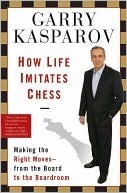More on this book
Community
Kindle Notes & Highlights
Every step, every reaction, every decision you make, must be done with a clear objective.
development,
term we use in chess to describe the deployment of your pieces for battle.
ask
what conditions would need to be fulfilled for his attack to succeed. He
if you play without long-term goals your decisions will become purely reactive and you’ll be playing your opponent’s game, not your own. As you jump from one new thing to the next, you will be pulled off course, caught up in what’s right in front of you instead of what you need to
achieve.
“Why?” Turns Tacticians into Strategists The strategist starts with a goal in the distant future and works backward to the present.
He evaluates where his fortunes lie in the position and establishes objectives. Then he works out the step-by-step moves to accomplish those aims.
So for every move always ask “Why?” and continue to ask it every time you come up with an answer or a new idea.
discipline that can be applied to just about every pursuit in life.
intermediate objectives are essential if we are to create conditions favo...
This highlight has been truncated due to consecutive passage length restrictions.
considering all the steps required to achieve it. What conditions are necessary for our strategy to succeed? What sacrifices will be required? What must change and what can we do to induce or enable those changes? And most important, why are we doing what we’re doing?
Kenichi Ohmae
“The strategist’s method is to challenge the prevailing assumptions with a single question: Why?”
You must ask this question constantly if you are to understand and develop and follow your strategy.
Everyone would greatly benefit from stopping before each move, each decision, and asking, “Why this move? What am I trying to achieve and how does this move help me achieve it?” Chess clearly shows us the power of “Why?” Every move has a consequence; every move either fits into your strategy or it doesn’t. If you aren’t questioning your moves consistently, you will lose to the player who is playing with a coherent plan.
tactics, the method of carrying out your strategy.
Effective tactics result from alertness and speed,
but they also require an understanding of all the possibilities at hand. Experience allows us to instantly apply the patterns we have successfully used in the past. Tactics involve calculations
trivial compared to strategy. Think of tactics as forced, planned responses, basically a series of “if—then” statements
The chance of making a mistake increases the further ahead you look.
A tactician feels at home reacting to threats and seizing opportunities on the battlefield. When your opponent has blundered, a winning tactic can suddenly appear and serve as both means and end.
tactical reaction.
Every time you make a move, you must consider your opponent’s response, your answer to that response, and so on.
a forceful sequence...
This highlight has been truncated due to consecutive passage length restrictions.
analyze the p...
This highlight has been truncated due to consecutive passage length restrictions.
compute the dozens of v...
This highlight has been truncated due to consecutive passage length restrictions.
If you don’t immediately exploit a tactical opportunity, the game will almost cer...
This highlight has been truncated due to consecutive passage length restrictions.
seize the opportunities that your str...
This highlight has been truncated due to consecutive passage length restrictions.
A key to developing successful strategies is to be aware of your strengths and weaknesses, to know what you do well.
“genius is one percent inspiration and ninety-nine percent perspiration.”
prophylaxis: the art of preventative play, strengthening your position and eliminating threats.
You must always be aware of your limitations and also of your best qualities. This knowledge allows you to both play your own game and adapt when it is required.
Even when I am forced on the defensive, I am constantly looking for a chance to turn the tables and counterattack.
where the player who makes the first mistake loses.
specialize in the accumulation of small advantages. They risk little and are content to slowly improve their position until their opponent cracks.
strategies—defensive, dynamic, maneuvering—can be highly effective in the hands of someone...
This highlight has been truncated due to consecutive passage length restrictions.
Risk-takers coexist with conservative managers
You Cannot Always Determine the Battlefield
being able to play in different styles when necessary. Sometimes you are forced to fight on unfamiliar terrain; you can’t run away when conditions aren’t to your liking. The ability to adapt is critical to success.
having lost the battle on his territory, he wasn’t able to make a successful transition to fighting on mine,
experience of adapting under fire
the failure to adapt almost always brings dire consequences.
wrong side of change.
Being too far ahead of your environment can be just as bad as lagging behind your competitors.
Change can be essential, but it should only be made with careful consideration and just cause. Losing can persuade you to change what doesn’t need to be changed, and winning can convince you everything is fine even if you are on the brink of disaster. If you are quick to blame faulty strategy and change it all the time, you don’t really have any strategy at all. Only when the environment shifts radically should you consider a change in fundamentals.
We all must walk a fine line between flexibility and consistency. A strategist must have faith in his strategy and the courage to follow it through and still be open-minded enough to realize when a change of course is required.
The keys to great preparation are self-awareness and consistency. Steady effort pays off, even if not always in an immediate, tangible way.
stick with my routine as closely as possible.


